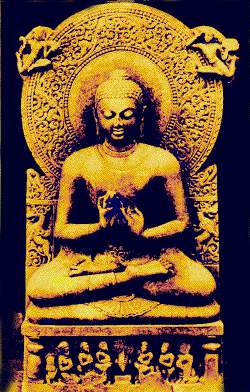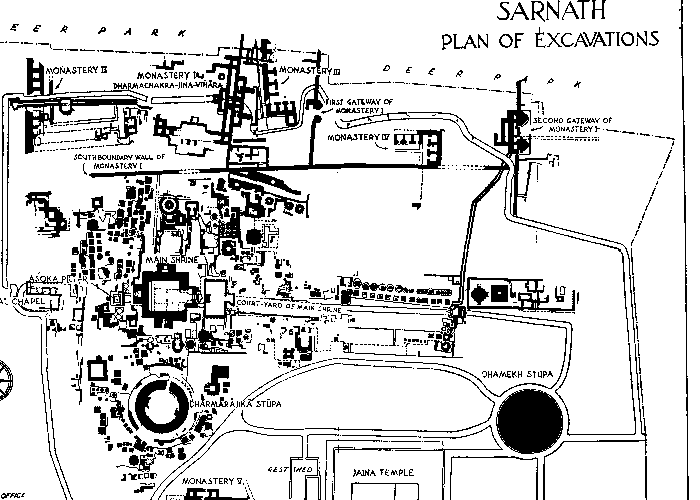DHAMAKA JAYATU
"VICTORY TO THE DHARMA"
(inscribed on a clay seal from the 12th c. found at Sarnath during the excavations)

Buddha Turning the Wheel, Delivering the First Sermon
Gupta period statue unearthed in Sarnath, 1905

This partial ground plan of the excavations at Sarnath shows some of the extensive ruins
(north is toward the top of the page).
As for the Dharmarajika stupa built by Asoka (circle at lower left), nothing remains but the foundation. It had been enlarged six different times, the original being over 40 ft. across at the base. The second enlargement (Kushan Period, 5th - 6th c.) added a circumambulatory path (pradakshinapatha) almost 15 ft. wide, encompassed by a solid outer wall 4.5 feet high, pierced with four doorways in the four directions. In the 7th c. the walkway was filled in and staircases built to access the raised path. More work was done in the 9th and 11th centuries. The sixth and last encasing took place in the 12th century.
In 1794, Jagat Singh, Dewan of Raja Chet Singh of Banaras, in the process of collecting materials to build a bazaar (re: mall), pulled down the Dharmarajika stupa. In the process, thousands of image-plaques were discovered including one of the Buddha inscribed from 1026. A green marble box was also discovered. It contained bone relics, pearls, rubies, silver and gold earrings. These depredations brought Sarnath to the world's attention.
In 1835-6, Cunningham carried out more extensive excavations. He found the OM YE DHARMA dharani inscribed on a stone slab in the Damekh stupa and provided the Indian Museum in Calcutta with a large collection of images, but even after this, many sculptures and carved stones left by Cunningham were carted away by local interests and employed in constructing two bridges over the Barna River.
And mark this; nearly every excavation done at Sarnath has revealed signs of destruction by fire. All the buildings had been sacked and burned more than once.
Over 300 images have been retrieved from the ruins of Sarnath, revealing its importance as an artistic center from the Gupta period up through the 11th century.
Sources
Holy Places of the Buddha. Crystal Mirror Series, Volume 9, edited by Tarthang Tulku,
research. compiling and ms. prep by Elizabeth Cook, Dharma Publishing, 1994
Sarnath by V.S.Agrawala, Archeological Survey of India, Government of India, 1992
©Turtle Hill Sangha, 2010
back to sarnath